Getting Started with Tower System Development Board for Kinetis Ultra-Low-Power KL82 MCUs
Contents of this document
-
Plug It In
-
Get Software
-
Build, Run
-
Create
Sign in to save your progress. Don't have an account? Create one.
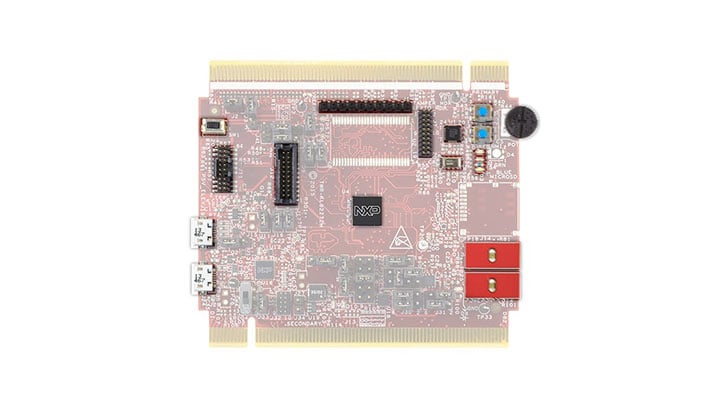
Purchase your Tower System Development Board for Kinetis Ultra-Low-Power KL82 MCUs
1. Plug It In
Let's take your TWR-KL82Z72M for a test drive! You have the choice of watching the sequence in a short video or following the detailed actions list below.
1.2 Run the Out-of-Box Demo
Your TWR-KL82Z72M comes loaded with a "bubble level" demo that leverages the on-board accelerometer. After the USB cable is plugged in, all the LEDs on the board will flash. Then when the board is flat, the RGB LED is turned off, and when the board is tilted, the yellow or blue LEDs gradually illuminate based on the degree of tilt on the X- and Y-axis.
2. Get Software
Installing software for the TWR-KL82Z72M
2.1 Jump Start Your Design with the Kinetis SDK
The Kinetis Software Development Kit (SDK) is complimentary and includes full source code under a permissive open-source license for all hardware abstraction and peripheral driver software.
Click below to download the KL82Z standalone SDK package
2.2 Install Your Toolchain
NXP® offers a complimentary toolchain called Kinetis Design Studio (KDS).

Want to use a different toolchain?
No problem! The Kinetis SDK includes support for other tools such as IAR , Keil and command-line GCC .

2.3 Tool Update
If using Kinetis Design Studio or Arm GCC tool chains, the latest Segger J-Link software tools need to be downloaded and installed. This update is required for those tools to support the KL80 family. Ensure you install this update after installing the IDE of your choice.
First, download the latest “Software and documentation pack”, at least version 5.02, from Segger
Then Install the software and at the end of the installation, there will be a dialog box asking to update installed IDEs. Make sure the KDS 3.0.0 IDE is checked if using Kinetis Design Studio.
2.4 PC Configuration
Many of the example applications output data over the MCU UART so you'll want to make sure that the driver for the board's virtual COM port is installed. Before you run the driver installer, you MUST have the board plugged in to your PC.

With the serial port driver installed, run your favorite terminal application to view the serial output from the MCU's UART. Configure the terminal to 115200 baud rate, 8 data bits, no parity and 1 stop bit. To determine the port number of the TWR-KL82Z72M's virtual COM port, open the device manager and look under the "Ports" group.
Not sure how to use a terminal application? Try one of these tutorials: Tera Term Tutorial, PuTTY Tutorial.
3. Build, Run
Build and Run SDK Demos on the TWR-KL82Z72M
3.1 Explore the SDK Example Code
The Kinetis SDK comes with a long list of demo applications and driver examples. To see what's available, browse to the SDK 'examples' folder of your SDK installation and select your board, the TWR-KL82Z72M (<sdk_install_directory>/examples/twrkl82z72m</sdk_install_directory>).
To learn more about demo applications or driver examples, open the Kinetis SDK Demo Applications User's Guide, located in
<sdk_install_directory>/doc</sdk_install_directory>.
3.2 Build, Run and Debug SDK Examples
If one or more of the demo applications or driver examples sounds interesting, you're probably wanting to know how you can build and debug yourself. The Getting Started with Kinetis SDK guide provides easy, step-by-step instructions on how to configure, build, and debug demos for all toolchains supported by the SDK.
Use the guide below to learn how to open, build and debug an example application using the Kinetis Design Studio (KDS) IDE.
Use Kinetis Design Studio
1. Install Eclipse Updates
Before using KDS IDE with KSDK, some KDS Eclipse updates must be applied. Without this update, Eclipse cannot generate KSDK-compatible projects.
Note for Mac® OS Users
The steps required for Mac OS are identical to Windows; the only difference is that the IDE looks slightly different.
Note for Linux® OS Users
The steps required for Linux are identical to Windows; the only difference is you need to launch KDS IDE from the command line as the root user when installing these updates. On the command line, use this command, assuming the default KDS IDE install path:
user@ubuntu:~$ sudo
/opt/NXP/KDS_x.x.x/eclipse/kinetis-design-studio
-
Select "Help" → "Check for Updates"
On the selection screen, uncheck all the components except for the “Processor Expert® for Kinetis” component
-
Click on “Next” and follow the prompts to finish the installation of the Processor Expert update
-
Once the Process Expert update is complete, Kinetis Design Studio will restart, and now the KSDK Eclipse Plugin can be installed
-
Select "Help" → "Install New Software"

-
In the Install New Software dialog box, click the "Add" button in the upper right corner. Then, in the Add Repository dialog, select the "Archive" button

-
In the Repository archive dialog box, browse the KSDK install directory
-
Enter the
/tools/eclipse_updatefolder and select theKSDK_file_Eclipse_Update.zip -
Click "Open", and the "OK" button in the Add Repository dialog box
-
The KSDK update shows up in the list of the original Install dialogs

-
Check the box to the left of the KSDK Eclipse update and click the "Next" button in the lower right corner
-
Follow the remaining instructions to finish the installation of the update
-
After the update is applied, restart KDS for the changes to take effect
Using a different toolchain?
Use IAR
1. Build the platform library
These steps show how to open a demo workspace in IAR Embedded Workbench, how to build the platform library required by the demo, and how to build the demo application. The example used below is for the hello_world demo, but similar steps can be applied to any demo in the KSDK.
-
Open demo workspace (*.eww file) in:
/examples/twrkl82z72m/demo_apps//iar After the workspace is open, two projects are shown: one for the KSDK platform library and one for the demo. Also, the platform library project is bold, indicating that it is the active project. The active project can be changed at any time by right clicking on the desired project and selecting "Set as Active" or via the build target drop-down at the top of the workspace browser

-
There are two project configurations (build targets) supported for each KSDK project:
- Debug - Compiler optimization is set to low, and debug information is generated for the executable. This target should be selected for development and debug
- Release - Compiler optimization is set to high, and debug information is not generated. This target should be selected for final application deployment. The tool allows you to select either the Debug or Release configuration on a per-project basis, but since the demo has a dependency on the platform library, whichever configuration is selected for the demo must also be selected for the platform library. Selecting a configuration in the drop-down also makes whichever project and configuration that is selected the active project. For this example, select the "ksdk_platform_lib – Debug" target
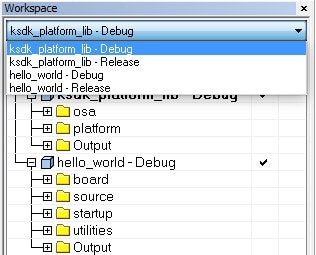
-
Click the "Make" button, highlighted in red below
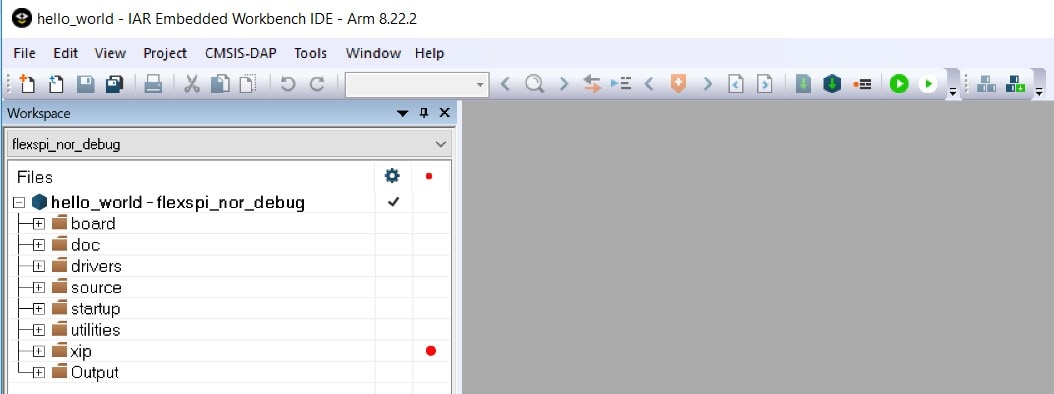
-
When the build is complete, the library (libksdk_platform.a) is generated in one of the following directories, according to the chosen build target:
/lib/ksdk_platform_lib/iar/KL8Z25615/debug/lib/ksdk_platform_lib/iar/KL8Z25615/release
2. Build a Demo Application
The KSDK demo applications are built upon the software building blocks provided in the Kinetis SDK platform library, built in the previous section. If the platform library is not present, the linker displays an error indicating that it cannot find the library. An easy way to check whether the library is present is to expand the Output folder in the ksdk_platform_lib project. If the platform library binary is not built and present, follow the steps on page 1 to build it. Otherwise, continue with the following steps to build the desired demo application.
-
If not already done, open the desired demo application workspace (*.eww file). This example's workspace file is located in:
/examples/twrkl82z72m/demo_apps/hello_world/iar -
Select the desired build target from the drop-down. For this example, select the "hello_world – Debug" target
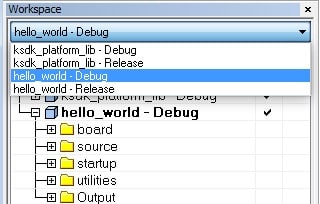
-
To build the demo application, click the "Make" button, highlighted in red below
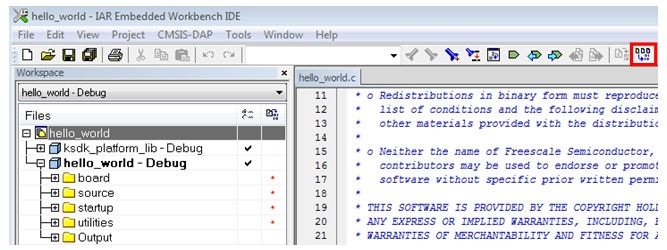
-
The build will complete without errors
3. Run a Demo Application
The TWR-KL82Z72M board comes loaded with the mbed/CMSIS-DAP debug interface from the factory. If you have changed the debug OpenSDA application on your board, visit OpenSDA Serial and Debug Adapter for information on updating or restoring your board to the factory state.
-
Connect the development platform to your PC via USB cable between the "SDAUSB" USB port on the board and the PC USB connector
-
Open the terminal application on the PC (such as PuTTY or TeraTerm) and connect to the debug COM port you determined earlier. Configure the terminal with these settings:
- 115200 baud rate
- No parity
- 8 data bits
- 1 stop bit
-
Click the "Download and Debug" button to download the application to the target

-
The application is then downloaded to the target and automatically runs to the main() function

-
Run the code by clicking the "Go" button to start the application

-
The hello_world application is now running and a banner is displayed on the terminal. If this is not the case, check your terminal settings and connections
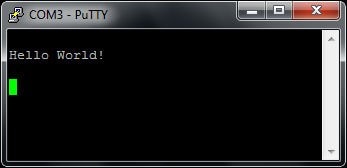
Use Keil® MDK
1. Install CMSIS device pack
After the MDK tools are installed, Cortex® Microcontroller Software Interface Standard (CMSIS) device packs must be installed to fully support the device from a debug perspective. These packs include things such as memory map information, register definitions and flash programming algorithms. Follow these steps to install the appropriate CMSIS pack.
-
Open the MDK IDE, which is called µVision. In the IDE, select the "Pack Installer" icon

-
In the Pack Installer window, navigate to the section with the Kinetis packs (they are in alphabetical order). The Kinetis packs start with "Keil::Kinetis" and are followed by the MCU family name, for example "Keil::Kinetis_K80_DFP". Because this example uses the TWR-K80F150M platform, the K80 family pack is selected. Click on the "Install" button next to the pack. This process requires an internet connection to successfully complete

-
After the installation finishes, close the Pack Installer window and return to the µVision IDE
2. Build the Platform Library
These steps show how to open the demo workspace in µVision, how to build the platform library required by the demo, and how to build the demo application.
-
Demo workspace files can be found using this path:
/examples/twrkl82z72m/demo_apps//mdkThe workspace file is named .uvmpw. For this specific example, the actual path is:
/examples/twrkl82z72m/demo_apps/hello_world/mdk/hello_world.uvmpwAfter the workspace is open, two projects show up: one for the KSDK platform library, and one for the demo. By default, the demo project is selected as the active project

-
Make the platform library project the active project since the library is required by the demo application to build. To make the platform library project active, right click on it and select "Set as Active Project". The active project has a black box around the project name. After it is active, the platform library project is highlighted

-
There are two project configurations (build targets) supported for each KSDK project:
- Debug — Compiler optimization is set to low, and debug information is generated for the executable. This target should be selected for development and debug
- Release — Compiler optimization is set to high, and debug information is not generated. This target should be selected for final application deployment
The tool allows selection of the build target based on the active project, so in order to change the configuration for the platform library it must be the active project. Choose the appropriate build target: "Debug" or "Release" from the drop-down menu
For this example, select the "ksdk_platform_lib Debug" configuration

-
Rebuild the project files by left-clicking the "Rebuild" button, highlighted in red

3. Build a Demo Application
The KSDK demo applications are built upon the software building blocks provided in the Kinetis SDK platform library, built in the previous section. If the platform library is not present, the linker displays an error indicating that it cannot find the library. If the platform library binary is not built and present, follow the steps on page 2 to build it. Otherwise, continue with the following steps to build the desired demo application.
-
If not already done, open the desired demo application workspace in:
/examples/twrkl82z72m/demo_apps//mdkThe workspace file is named
.uvmpw, so for this specific example, the actual path is:/examples/twrkl82z72m/demo_apps/hello_world/mdk/hello_world.uvmpw -
Make the demo the active project

-
To build the demo project, select the "Rebuild" button, highlighted in red

-
The build will complete without errors
4. Run a Demo Application
The TWR-KL82Z72M board comes loaded with the mbed/CMSIS-DAP debug interface from the factory. If you have changed the debug OpenSDA application on your board, visit OpenSDA Serial and Debug Adapter for information on updating or restoring your board to the factory state.
-
Connect the development platform to your PC via USB cable between the "SDAUSB" USB port on the board and the PC USB connector
-
Open the terminal application on the PC (such as PuTTY or TeraTerm) and connect to the debug COM port you determined earlier. Configure the terminal with these settings:
- 115200 baud rate
- No parity
- 8 data bits
- 1 stop bit
-
After the application is properly built, click the "Start/Stop Debug Session" button to download the application to the target and start the debugger

-
After clicking the "Debug" button, the application downloads to the target and should be running
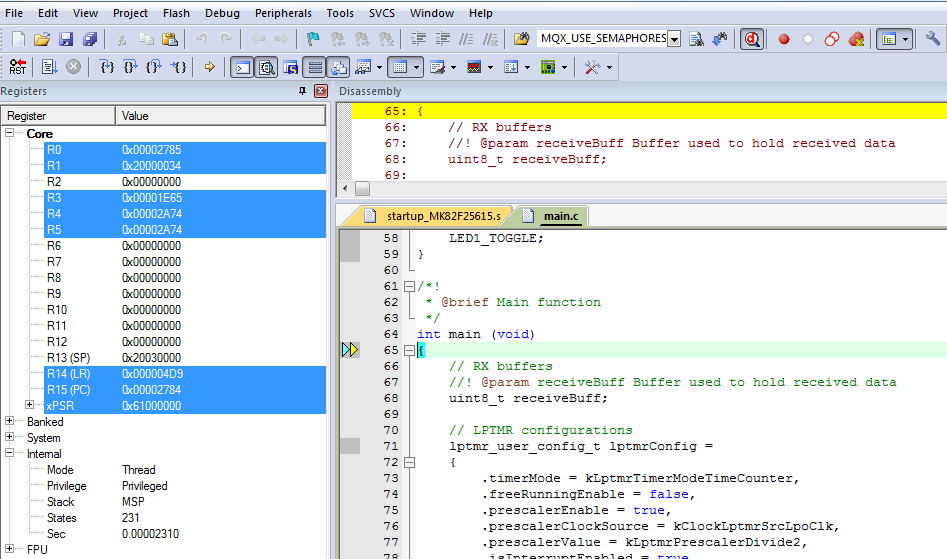
-
Run the code by clicking the "Run" button to start the application

-
The hello_world application is now running and a banner is displayed on the terminal. If this is not the case, check your terminal settings and connections
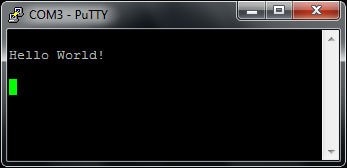
Use Arm® GCC
1. Set Up Toolchain
This section contains the steps to install the necessary components required to build and run a KSDK demo application with the Arm GCC toolchain, as supported by the Kinetis SDK. There are many ways to use Arm GCC tools, but this example focuses on a Windows environment. Though not discussed here, GCC tools can also be used with both Linux OS and Mac OSX.
Install GCC Arm Embedded Toolchain
Download and run the installer from GNU Arm Embedded Toolchain. This is the actual toolchain (i.e., compiler, linker, etc.). The GCC toolchain should correspond to the latest supported version, as described in the Kinetis SDK Release Notes.
Install MinGW
The Minimalist GNU for Windows (MinGW) development tools provide a set of tools that are not dependent on third party C-Runtime DLLs (such as Cygwin). The build environment used by the KSDK does not utilize the MinGW build tools, but does leverage the base install of both MinGW and MSYS. MSYS provides a basic shell with a Unix-like interface and tools.
-
Download the latest MinGW mingw-get-setup installer from MinGW - Minimalist GNU for Windows Files
-
Run the installer. The recommended installation path is
C:\MinGW, however, you may install to any location -
Ensure that the "mingw32-base" and "msys-base" are selected under Basic Setup

-
Click "Apply Changes" in the "Installation" menu and follow the remaining instructions to complete the installation
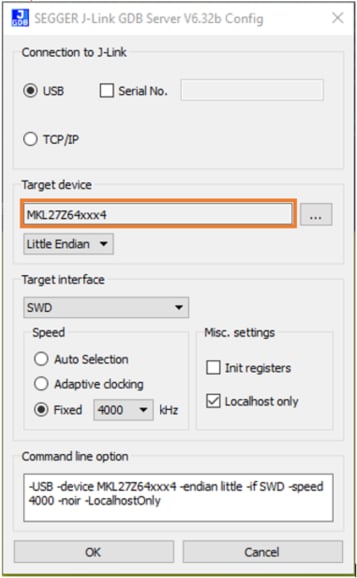
-
Add the appropriate item to the Windows operating system Path environment variable. It can be found under
Control Panel /System and Security/System/Advanced System Settingsin the "Environment Variables..." section. The path is:\binAssuming the default installation path,
C:\MinGW, an example is shown below. If the path is not set correctly, the toolchain does not work
-
Download CMake 3.0.x from Download CMake.
-
Install CMake, ensuring that the option "Add CMake to system PATH" is selected when installing. It's up to the user to select whether it's installed into the PATH for all users or just the current user. In this example, the assumption is that it's installed for all users

-
Follow the remaining instructions of the installer
-
You may need to reboot your system for the PATH changes to take effect
Add a New Environment Variable for ARMGCC_DIR
Create a new system environment variable and name it ARMGCC_DIR. The value of this variable should point to the Arm GCC Embedded tool chain installation path, which, for this example, is:
C:\Program Files (x86)\GNU Tools Arm Embedded\4.9
2015q3
Reference the installation folder of the GNU Arm GCC Embedded tools for the exact path name of your installation.

Install CMake
2. Build the Platform Library
-
Open a GCC Arm Embedded tool chain command window. To launch the window, from the Windows operating system Start menu, go to "Programs → GNU Tools Arm Embedded" and select "GCC Command Prompt"

-
Change the directory of the command window to the platform library directory in the KSDK:
/lib/ksdk_platform_lib/armgcc/KL82Z1287 -
There are two project configurations (build targets) supported for each KSDK project:
- Debug — Compiler optimization is set to low, and debug information is generated for the executable. This target should be selected for development and debug
- Release — Compiler optimization is set to high, and debug information is not generated. This target should be selected for final application deployment
There are batch files provided to build both configurations. For this example, the "Debug" target is built and "build_debug.bat" is typed on the command line. If the "Release" target is desired, type the "build_release.bat" instead. Alternatively, if using the command line is not desired, you can double click on the batch files from Windows Explorer.

-
When the build finishes, the output looks like the image below

-
The library (libksdk_platform.a) is generated in one of these directories, according to the build target:
/lib/ksdk_platform_lib/armgcc/KL82Z1287/debug/lib/ksdk_platform_lib/armgcc/KL82Z1287/release
3. Build a Demo Application
KSDK demo applications require that the platform library for the same build target (Debug or Release) is present. Please ensure that you follow the steps in section 7.2 prior to attempting to build a demo application.
To build a demo application, follow these steps.
-
If not already running, open a GCC Arm Embedded tool chain command window. To launch the window, from the Windows operating system Start menu, go to "Programs → GNU Tools Arm Embedded
" and select "GCC Command Prompt" 
-
Change the directory to the demo application project directory, which has a path like this:
/examples/twrkl82z72m/demo_apps/<demo_name>/armgccFor this example, the exact path is:
/examples/twrkl82z72m/demo_apps/hello_world/armgcc -
Type "build_debug.bat" on the command line or double click on the "build_debug.bat" file in Windows operating system Explorer to perform the build. The output is shown in this figure:

4. Run a Demo Application
The GCC tools require a J-Link debug interface. To update the OpenSDA firmware on your board to the latest J-Link app, visit OpenSDA Serial and Debug Adapter. After installing the J-Link OpenSDA application, download the J-Link driver and software package from SEGGER Downloads.
-
Connect the development platform to your PC via USB cable between the "SDAUSB" USB port on the board and the PC USB connector
-
Open the terminal application on the PC (such as PuTTY or TeraTerm) and connect to the debug COM port you determined earlier. Configure the terminal with these settings:
- 115200 baud rate
- No parity
- 8 data bits
- 1 stop bit
-
Open the J-Link GDB Server application. Assuming the J-Link software is installed, the application can be launched by going to the Windows operating system Start menu and selecting "Programs → SEGGER → J-Link J-Link GDB Server"
-
Modify the settings as shown below. The target device selection chosen for this example is the "MKL82Z128xxx7"

-
Hit OK to connect to the board. You may see a warning about licensing, so accept the terms to move on
-
After it is connected, the screen should resemble this figure:

-
If not already running, open a GCC Arm Embedded tool chain command window. To launch the window, from the Windows operating system Start menu, go to "Programs → GNU Tools Arm Embedded
" and select "GCC Command Prompt" 
-
Change to the directory that contains the demo application output. The output can be found in using one of these paths, depending on the build target selected:
/examples/<board_name>/demo_apps/<demo_name>/armgcc/debug/examples/<board_name>/demo_apps/<demo_name>/armgcc/releaseFor this example, the path is:
/examples/twrkl82z72m/demo_apps/hello_world/armgcc/debug -
Run the command
arm-none-eabi-gdb.exe demo_name.elf. For this example, it isarm-none-eabi-gdb.exe hello_world.elf
-
Run these commands:
- "target remote localhost:2331"
- "monitor reset"
- "monitor halt"
- "load"
- "monitor reset"
- "monitor go"
-
The application is now downloaded and halted at the reset vector. By executing the "monitor go" command, the demo application will begin
The hello_world application is now running and a banner is displayed in the terminal window

4. Create
Create an Application for the TWR-KL82Z72M
4.1 Get SDK Project Generator
Let's create our own project and make a simple SDK-based application. NXP provides an intuitive, simple project generation utility that allows creation of custom projects based on the Kinetis SDK.
4.2 Run the SDK Project Generator
After extracting the zip file, open the utility by clicking the KSDK_Project_Generator executable for your computer's operating system. Point the tool to your SDK installation path, name your project, and select the board that it uses as a reference. Click the Quick Generate button to finish.

4.3 Open Your Project
Your new project will be located in
/examples/twrkl82z72m/user_apps
. Open the project in your toolchain of choice by using the same
process described in section 3.2.
4.4 Write Some Code
Now, let's make our new project do something other than spin in an infinite loop. The SDK examples provide a board support package (BSP) to do various things specific to the board, including macros and definitions for items such as LEDs, switches and peripheral instances. To keep things simple, lets make the LED blink using the BSP macros.
Update the main() function in your project's main.c file with the following code:
Sign in to access this content and additional site features. Don’t have an account? Register now.
1
ore ips = ""
si amet, = ""
etu adi = CIN. elit, ? D D. eiusm : "em"
incidi (nt u) {
t do "re":
. ut = "M ad"
m, qui = "Strud "
ulla
oris "is":
ex e = "复制"
t. dui = "已复制"
in re
erit "n ":
it e = "复制"
eu fug = "已复制"
exce
int "ca":
t no = "コピー"
culpa = "コピー済"
t mol
m id es:
em ip
}
r sit am t,
secte;
// Piscing e it, s d do eiu mod tempor
didunt u_ lab();
// E magna al qua UT nim ad m
ven_am, _uis ();
D EXER("
\o\ Ullamco lab riS nisi t aliqu.\
");
// O cons QUAT dui au E I1
OLO1_IN;
reh
(;;)
{
E V1_IT;
dolo = 5000000;
iatur( exce--);
ECA1_CUP;
roide = 5000000;
offic(a des--);
lit a="m id est la"
}
4.5 Build, Download, Run
With the changes made to your main() function, build your application. Remember to build the SDK platform library first if you did not build any of the other SDK examples in the previous steps. Once the build is complete, download the application to your board.
If you need help figuring out how to build, download or run an application, reference your tool-specific guide from section 3.2.
Tera Term Tutorial
Tera Term Tutorial
Tera Term is a very popular open source terminal emulation application. This program can be used to display information sent from your NXP development platform's virtual serial port.
- Download Tera Term from SourceForge. After the download, run the installer and then return to this webpage to continue
- Launch Tera Term. The first time it launches, it will show you the following dialog. Select the serial option. Assuming your board is plugged in, there should be a COM port automatically populated in the list
- Configure the serial port settings (using the COM port number identified earlier) to 115200 baud rate, 8 data bits, no parity and 1 stop bit. To do this, go to Setup → Serial Port and change the settings
- Verify that the connection is open. If connected, Tera Term will show something like below in it's title bar.
- You're ready to go


PuTTY Tutorial
PuTTY Tutorial
PuTTY is a popular terminal emulation application. This program can be used to display information sent from your NXP development platform's virtual serial port.
- Download PuTTY using the button below. After the download, run the installer and then return to this webpage to continue
- Launch PuTTY by either double clicking on the *.exe file you downloaded or from the Start menu, depending on the type of download you selected
- Configure In the window that launches, select the Serial radio button and enter the COM port number that you determined earlier. Also enter the baud rate, in this case 115200
- Click Open to open the serial connection. Assuming the board is connected and you entered the correct COM port, the terminal window will open. If the configuration is not correct, PuTTY will alert you
- You're ready to go







